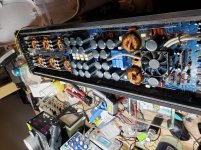How are they being used in the circuit?
Large resistors are used where they are expected to dissipate a lot of heat. The color of these seems to indicate that they have run hot for a long time.
Does the amp have any fans that would cool them when the amp if fully assembled?
Large resistors are used where they are expected to dissipate a lot of heat. The color of these seems to indicate that they have run hot for a long time.
Does the amp have any fans that would cool them when the amp if fully assembled?
How are they being used in the circuit?
250F isn't excessive for this type of resistor. I don't know what's normal for this amp. Maybe someone else can tell you what's normal.
250F isn't excessive for this type of resistor. I don't know what's normal for this amp. Maybe someone else can tell you what's normal.
is it normal for these resistors to reach temperatures around 230-250°f just idli g?
Such a poor design.
Meant to be used till failure and tossed out.
This is part of the "throw-away" generation of products.
Is absolutely normal.
This resistors are used as pulldown resistor to quickly discharge the rail caps when the amp tunr off.
This resistors are used as pulldown resistor to quickly discharge the rail caps when the amp tunr off.
Is absolutely normal.
This resistors are used as pulldown resistor to quickly discharge the rail caps when the amp tunr off.
And in the meantime, they're a tremendous source of radiated heat, tucked in between those capacitors, which causes them to prematurely fail.
Poor layout design.
😱Poor design.
Their being mounted so close to each other seriously degrades their dissipation capacity.
You sure?
What´s the point?
This is not a high power tube transmitter with 1500V +V supply.
Supply discharge resistors are used sometimes, but at those voltages typigal values could run from 1k to 10k, no more than 1 W dissipation, and would ensure cap discharge within a minute or two anyway; IF they are used for that function the design is A MESS.
Dissipating BIG watts all the time and discharging caps in 10 seconds? 😱
Only in the Car Audio World 🙄
I bet the model name includes bombastic names such as "Detonator", "Destroyer", "Bomber" .... or to keep up with the news: "Beirut Blaster" 🙄
Their being mounted so close to each other seriously degrades their dissipation capacity.
Is absolutely normal.
This resistors are used as pulldown resistor to quickly discharge the rail caps when the amp tunr off.
You sure?
What´s the point?
This is not a high power tube transmitter with 1500V +V supply.
Supply discharge resistors are used sometimes, but at those voltages typigal values could run from 1k to 10k, no more than 1 W dissipation, and would ensure cap discharge within a minute or two anyway; IF they are used for that function the design is A MESS.
Dissipating BIG watts all the time and discharging caps in 10 seconds? 😱
Only in the Car Audio World 🙄
I bet the model name includes bombastic names such as "Detonator", "Destroyer", "Bomber" .... or to keep up with the news: "Beirut Blaster" 🙄
Last edited:
Sometimes, the simplest of circuits are the worst. Linear voltage regulators have to be the worst, in both home and car audio.
It would be better if they used a simple, active CCS to discharge only when the amp was switched off like MTX did in some of their amps.
It would be better if they used a simple, active CCS to discharge only when the amp was switched off like MTX did in some of their amps.
among other things, these resistors heat up in an absurd way and therefore are part of the cause of the high current draw at idle of these Korean amplifiers, as well as the heating of the large 47ohm resistors at the output of the amplifier stages.Sometimes, the simplest of circuits are the worst. Linear voltage regulators have to be the worst, in both home and car audio.
It would be better if they used a simple, active CCS to discharge only when the amp was switched off like MTX did in some of their amps.
Definitely a design to improve, but certainly one of the most brutal designs.
Sometimes, the simplest of circuits are the worst. Linear voltage regulators have to be the worst, in both home and car audio.
.
Could you expand on that please Perry, do you mean in terms of being run too hot by design?
- Home
- General Interest
- Car Audio
- Resistors heating up

